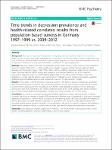Time trends in depression prevalence and health-related correlates: results from population-based surveys in Germany 1997–1999 vs. 2009–2012
Bretschneider, Julia
Janitza, Silke
Jacobi, Frank
Thom, Julia
Hapke, Ulfert
Kurth, Tobias
Maske, Ulrike E.
Background
Although an “epidemic” of depression is frequently claimed, empirical evidence is inconsistent, depending on country, study design and depression assessment. Little is known about changes in depression over time in Germany, although health insurance companies report frequency increases. Here we examined time trends in depression prevalence, severity and health-related correlates in the general population.
Methods
Data were obtained from the mental health module of the “German Health Interview and Examination Survey for Adults” (2009–2012, n = 3265) and the mental health supplement of the “German National Health Interview and Examination Survey 1998” (1997–1999, n = 4176), excluding respondents older than 65. 12-month major depressive disorder (MDD), severity and symptoms were assessed based on the WHO Composite International Diagnostic Interview. Health-related quality of life (SF-36), self-reported sick days or days with limitations in normal daily life activities were examined, too. Calculations were carried out population-weighted. Additional age-standardized analyses were conducted to account for demographic changes.
Results
Overall, MDD 12-month prevalence remained stable at 7.4%. Women showed a shifted age distribution with increased prevalence at younger ages, and increasing MDD severity. Time trends in health-related correlates occurred both in participants with and without MDD. Mental health disability increased over time, particularly among men with MDD, reflected by the mental component score of the SF-36 and days with activity limitation due to mental health problems. Demographic changes had a marginal impact on the time trends.
Conclusions
In contrast to the ongoing international debate regarding increased depression rates in western countries, we found no increase in overall MDD prevalence in Germany over a long period. In conclusion, increased depression frequencies in national health insurance data and growing health care costs associated with depression are not attributable to overall prevalence changes at a population level. However, shifted age distribution and increased severity among women may reflect a rising depression risk within this specific subgroup, and changes in health-related correlates indicate a growing mental health care need for depression, particularly among men.
Dateien zu dieser Publikation

